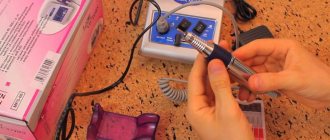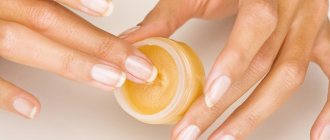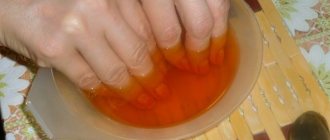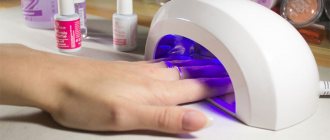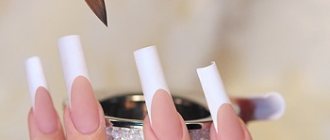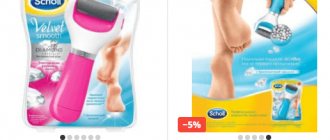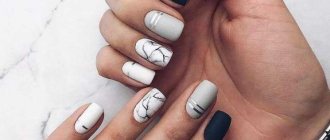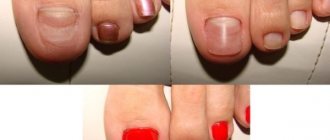What is abrasiveness?
The word “abrasiveness” refers to the hardness of the nail file. High-quality treatment of the nail plate largely depends on the degree of rigidity with which the file is chosen. After all, if it does not meet the norm, you can damage the nail.
How is the abrasiveness of files measured? Usually in grits. This unit of measurement clearly demonstrates the accumulation of those same abrasive particles on the surface of the manicure tool used. The lower the indicator, the greater the rigidity.
It is not advisable to choose a nail file simply by eye; it is better to decide what exactly it is needed for. This makes it easy and hassle-free to select the appropriate degree of hardness.
The value of the abrasiveness number of nail files
Surely many have noticed more than once a certain set of numbers on each file: for example, 180/240. How can this be explained? It’s simple, this means that on one side the file has 180 abrasive particles, and on the other there are 240. And these indicators are precisely grits. For example, what is a 180/240 file intended for?
This can be found out by analyzing several specific groups into which nail files are divided according to their indicators:
- 60–80 grit is a hard nail file. These files are primarily intended for adjusting the length of artificial nail plates. It is better to avoid treating natural nails with such files. If this is not done, the result may be delamination.
- 100–150 grit - such a file will have a slightly lower degree of hardness. A working tool with such indicators is used to adjust artificial nails, and with its help you can give it any shape.
- 150–240 grit – medium hardness. However, it cannot be used for natural nails either, only for artificial ones. Usually, with the help of such a file, the final shape of the nail plates is made and the necessary alignments are made.
- 240 grit is a high abrasiveness of files for natural nail plates.
- 240–400 grit – soft nail file. It is used to correct nails and also polish them.
- 400–900 grit - a file with a similar indicator may well be useful in preparing nails for polishing.
- 900–1200 grit – these can be microabrasives and buffs, which are designed to polish the nail plate to a mirror shine.
What tasks can a nail polishing file handle?
The polishing tool has an undeniable advantage - only it allows you to bring the nail plate into its proper form, namely:
- Removes uneven nails and makes them smooth.
- Removes roughness and prepares the nail for applying varnish.
- Removes varnish residues or stains from dyes.
- Improves the appearance of nails, making them beautiful, well-groomed and shiny.
- Stimulates the growth of marigolds, improving blood circulation.
Usually, after the polishing procedure, the nails become glossy, and it is simply impossible not to pay attention to this. But the process should be moderate, otherwise polishing will make the nails weak and brittle. This procedure is one of the components of nail care. With its help, the nail plate will become beautiful and healthy. For best results, you should choose the right tool and master the technique of working with it.
Read material on the topic: How to properly polish nails - rules of care from the best specialists
Measuring the abrasiveness of a file for natural nails
So, what kind of files are needed for natural nails? Typically, the abrasiveness of nail files should be 180/240 grit. However, it is best to stick to another indicator - 240. What is the reason for this? If the degree of rigidity is high, this means that the file will have a gentle effect on the nail plate.
Typically, a high index file can be used for polishing, but not for correction. If the hardness of a manicure tool starts from 900 grit and ends at 1200, this means that it is more suitable for grinding.
Set of nail files
Files for gel nail extensions are chosen not only by shape; factors such as the material from which they are made, the base and abrasiveness also play an important role in this. By abrasiveness we mean the degree of hardness, which is usually measured in grit. If the amount of grit is less, then the surface of the nail file is rough, and if on the contrary, then this means that it is soft.
For nail extensions, it is best to choose a coarse file, the value of which is from 80 to 180 grit. If grinding and polishing is required, then you need to opt for an abrasive coating of 900-1200 grit.
In addition, the abrasive material can be either artificial or natural. It is best to choose nail files that have a garnet coating, because they are of better quality and will last a long time. Cheap tools, but quite practical options, are coated with silicon carbide. Among other things, sometimes zinc is added to this composition, which means that the file is protected from dust and will also serve for a long time.
If we talk about the basis, it can be different. Let's figure out which basis is suitable for what. A ceramic file is quite suitable for natural nail plates. In addition, it is able to seal the edges of marigolds that periodically peel. This tool also smoothes out the shape of the nail and removes dead skin around it.
If the nail file has a metal base, then do not doubt its reliability. However, this tool has one significant drawback: it can damage the nails in such a way that they peel off. That is why you should use this nail file carefully.
Plastic files or even cardboard ones are considered among the most popular. They are not that expensive, and they do not damage brittle and fragile nails. But this manicure tool wears out very quickly - after just six months you can throw away the nail file and buy a new one. In addition, it is not recommended to wash such a nail file, otherwise it can later cause an infection.
Glass files look quite attractive and do not damage your nails. But if so
If the nail file accidentally falls on the floor, it may break. This factor must be taken into account when choosing a tool. And it is advisable to carry a glass nail file with you anywhere in your purse in a case, otherwise its service life after purchase will be short.
What is the abrasiveness of an artificial nail file?
If you take into account a file for artificial nails, in this case it is best to choose a tool with the least degree of rigidity.
In addition, if you want to shape your nails, then the file should have a value of no more than 100 grit. In the case of simple filing, use tools with an abrasiveness of 100 to 180 grit.
Choosing the right file for grinding and polishing nails
You should not miss such an important step as choosing the appropriate tool. Glass and ceramic nail files are considered the best. After them, the nail plates do not separate. If a girl, for example, has thin and weak nails, then she needs a polishing file with wax.
As for a fine-grained file, it will be ideal exclusively for the free edge. Moreover, you need to move in one direction. A metal tool will not work in this case, because it can lead to splitting of the nails. It is often not worth using a tool that has a high degree of abrasiveness. In addition, once a year is enough. If you carry out this procedure frequently, your nails will become brittle and unsightly.
The abrasiveness discussed above is measured in special units - grits. So there is a mark on the file “180/240”, this means that one side has an abrasiveness of 180. Strong nails are treated with this side. As for the second side, an abrasiveness of 240 grit is the most gentle indicator.
When sanding thin nails, it is best to use tools with an abrasiveness of 400 to 500 grit. If your nails are strong, then a file with an abrasiveness of 240–300 grit is suitable.
Does the abrasiveness of nail files depend on the material?
As for the material from which nail files are usually made, it can be either artificial or natural.:
- Glass files are considered one of the best for correcting natural nails. And all because they do not cause any harm to the nails. In addition, such tools can be easily washed.
- Crystal manicure tools also cut very well. With them it is possible to create smooth and soft edges. Typically, such nails no longer require further polishing.
- Fabric files are usually flexible, and their middle part is synthetic, plastic or wood. This product is not cheap.
- Files with polyethylene foam are usually called buffs. They are needed for polishing. This tool is easy to clean and does not absorb water.
- There are also nail files with spraying. They are usually ceramic. With such tools you can create different shapes for your nails, as well as remove rough skin near the nails.
For example, it is worth considering the classification of files according to abrasive coating:
- If the file is covered with pomegranate particles, then, as a rule, it has a wooden frame. But such a manicure tool will not be cheap. In addition, garnet abrasive particles are not sharp, which means that the file will last a long time.
- The files are also coated with a silicon hybrid. As a rule, these are black-blue crystals with hard and sharp edges. With the help of such a nail file it is easy to give any shape.
- Silicon carbide is also used for coating. Due to the zinc coating, the entire surface of such a file will be smooth. In addition, there will be no near-abrasive depressions, which means that no dust will accumulate.
- Aluminum oxide crystals are not as sharp as those of the silicon hybrid. The file itself is hard and tough. In another way it is called a saw stone.
Abrasiveness of manicure files
Just a couple of decades ago, all ladies used only metal nail files and had no idea how many varieties of files would appear in the assortment of specialized beauty stores.
Today, you can divide nail files into types according to their shape and the material from which they are made.
Form
The shape of the files is divided into several categories:
- Direct
Straight files are used everywhere for manicure and pedicure. Any materials can be used to make straight files.
- Curved, shaped like a boomerang
Boomerang-shaped files have become widespread. Their shape is perfectly adjusted and as comfortable as possible. Such files are usually made of paper with an emery coating.
- Buffs
Buffs are used in manicure to polish and polish nails. Spraying on blocks of various abrasiveness.
- Curly
Files of unusual shapes and bright colors are usually purchased for children's manicures.
Materials
The materials from which nail files are made today are varied. The main categories include:
- Ceramic
A new type of files is ceramic. The file is indispensable in everyday care not only for nails, but also for rough skin of the elbows and knees.
- Glass
A glass or crystal file is ideal for natural nails. The tool gently cuts off the edge and carefully polishes. The disadvantage of such a file is its fragility: the file is easy to break.
- Metal
Metal files are a tribute to habit. It has long been established that such files can be unsafe and can easily injure the nail plate. The edge of the nail, cut down with such a tool, peels and crumbles. The exception to working with such a file is artificial nails.
- Emery
Paper or cardboard files coated with a layer of granite or quartz chips. These files have varying degrees of hardness and are suitable for both rough processing of artificial nails and soft polishing. An alternative to such a file today is a plastic tool.
Wooden and laser files have become innovations in the market of manicure tools. It's worth taking a closer look at them.
To perform a high-quality manicure, you should never neglect the choice of material from which the nail file will be made. Not only the quality of work depends on this seemingly simple manicure tool. Often, a file can cause injury to the cuticle, thinning and splitting of the nail plate. You can choose a set of necessary tools from professional accompanying products for MASURA manicure.
Rigidity
The measure of dusting on a nail file (abrasiveness) for manicure is grit. The lower the grit number of your file, the harder it is. The abrasiveness of the nail file coating can be divided into several categories:
- File 80-150 grit - suitable for artificial nails. The spraying of such a tool is very tough and requires care. Such a file can easily injure a natural nail or the skin around the nail plate.
- File 150-240 grit - may be needed when shortening the free edge of a natural nail, processing an acrylic nail before applying gel polish, polishing it and giving it the desired shape.
- File 240 - 600 grit - designed for working with natural nails. It gently polishes and corrects the shape of the natural nail, preparing it for final polishing.
- A file with an abrasiveness of 1000 grit or higher allows you to polish and process the edge of a natural nail. These files will make your nails shiny even without the use of decorative coatings.
File care
It is important to take care of your files. After each use, wash the instrument with warm soapy water. Unfortunately, coated paper files cannot be washed. They must be cleaned with a stiff brush. Such files in manicure salons should be strictly individual. The main requirement: files that do not undergo sterilization and disinfection must be strictly for individual use. A tool without the necessary care products can become a source of fungal infection.
Types of sanding files for nails and polishing
No less important is the abrasiveness of the files for grinding the nail plate itself. After all, without this it is almost impossible to achieve impeccable nail beauty. Now there is a large selection of manicure tools used for these purposes.
Buffs
Buffs are shaped like bars. What is the abrasiveness of the buff? Often, each facet of the buff is used for its intended purpose: first there is grinding, then polishing, and everything must be done in a clear sequence. Any unevenness on the nails is eliminated using the side whose abrasiveness is less than the others; various defects can be eliminated with a side with small grains.
Also, buffs can have different bases. Manufacturers mainly opt for polyethylene foam. Also, suede or fabric is of special quality; in addition, they can easily be used to process long natural nails.
A buff for natural nails should not be low abrasive. This tool is most suitable for artificial plates. If you polish natural nails, it is advisable to be very careful. This must be done for the simple reason that polishing involves removing the top layer of the nail plate itself, resulting in its thinning.
Nail files
There is a huge variety of files for polishing nails, and their abrasiveness should also differ. A low degree is most suitable for processing artificial plates, but for natural ones it is best to take note of a soft tool.
If the file has 300–400 grit, this may mean that it is good for removing small irregularities on the nails. But if the indicator is from 900 to 1000, then with this tool you can achieve excellent shine.
How to choose an abrasive nail file?
It’s not always possible to come to the store and buy a nail file you like just because, for example, it’s pink. Here it is important to consider the thickness of the nail plate. To do this, press your thumb on the very tip of your index nail. What will we get? This way you can easily bend the nail without feeling any pain. This indicates that the nail has a thin structure. If it still hurts a little, but the plate itself does not bend, the nail is thick.
You can also determine the thickness by color. In this case, unpainted nails are brought to the light. A thick plate will appear cloudy, while a thin plate will appear translucent. Now let's get down to business. For thin nails, it is better to choose ceramic or glass files that will not contribute to delamination. Ceramic may slightly damage such a nail.
If the thickness is average, then you should pay attention to files for natural nails, the abrasiveness of which exceeds 120 grit. Those with thick nail plates can please themselves with metal files. This way you can choose the most suitable tool for yourself.
How to determine the quality of a nail file?
Despite the variety of manicure tools, not all can be considered of sufficient quality. And hardly anyone will have the desire to use a bad nail file. Therefore, before you give money for a product, you should pay attention to several signs that will openly demonstrate the degree of its quality:
- The nail file should be flexible. In this case, it will not damage the nail, and will serve its owner for a long time.
- Between the frame and the surface that is intended for work, a special gasket is required.
- If the base of the nail file is made of plastic, then it will be the most reliable. The same cannot be said about a wooden frame.
Which foundation to choose
It is difficult to choose files for natural nails, since they must be moderately hard and not injure the structure of the plate. An equally important factor when buying a file is its base; depending on its type, the following types of files are distinguished:
- Metal files. They are distinguished by their reliability and versatility. Their disadvantage is that they contribute to the delamination of the plates. This manicure tool has not lost its leadership position for several decades, this can be explained by its low cost and long service life. Modern manicurists do not recommend using tools of this type on natural nails, as they harm the structure of the nail. It is better to save them for thick plates on the legs.
- Ceramic nail files. They are suitable for peeling and brittle natural nails. They are unlikely to be able to correct the shape of artificial nails. Ceramic files are also called silicon files; due to their effectiveness, they even received the title of “healing”, as they carefully align the free edge of the nail. They can even be used to remove dead skin around the nail plate.
- Glass files. They attract attention with their appearance: beauty and neatness, but this is not their only advantage. Glass files are gentle on the plates without causing them to delaminate. They are universal, so they are suitable for treating any nails. Their high price is justified by wear resistance and convenience. But, it should be noted that inattention can contribute to the loss of the nail file: they should not be exposed to contrasting temperatures and should not be dropped, as they are very fragile. It is recommended to store such a file in a special organizer.
- Files on cardboard or plastic base. This type of files is called “sand” files; they are especially popular at the moment due to the fact that they are highly soft and suitable for frequently breaking plates. Moreover, they are inexpensive. The stores offer a huge assortment of such files, you can choose one for every taste and budget. The disadvantages include their relative fragility with constant use - 3 months. They also do not tolerate exposure to water.
- Laser files. They appeared quite recently, but have already gained popularity. Their peculiarity is that they are not only able to change the shape and length of the plates, but also remove the cuticle. They have a fine diamond coating, but their main difference is the presence of small depressions. Laser files are suitable for polishing natural nails.
Therefore, if your nails are highly sensitive, then a fine-grained crystal file will suit them. A metal file should be excluded from tools for caring for natural nails, as it scratches and damages the plate.
How to use nail files correctly?
It is best to file your nails in one direction without changing it. If you make chaotic movements, in this case, separation of the nail plate may occur. In order to create a shape for the nails, it is recommended to file one free edge from the corner to its center, and the file should be at an angle.
The nail is visually divided into two parts and the edges are sawed until the desired shape has acquired its clear outline. There is no need to rush, otherwise there will be a risk of damage to the nail plate.
Typically, nails are filed once a week; you should not do this more often. During this time, the nail will recover well after such manipulations. It is best to polish once a month, otherwise the nail plate will become thin. It is also recommended to polish only dry nails, never wet ones.
Thus, having such information and adhering to some rules, you can choose a file for yourself, the abrasiveness of which will be the most suitable. Thanks to this, you can create a suitable shape for your nails without damaging them.
Read more about the abrasiveness of nail files
As mentioned above, nail files vary in degree of hardness. The table below shows the main characteristics of files depending on their abrasiveness:
For each type of work, a file of different types of hardness is selected.
Soft sanding
For this type of care, it is recommended to use a nail file with an abrasiveness of 300-350 grit. The file should move from the free edge to the center. Sanding is carried out until the applied product is completely absorbed. During the maintenance process, yellowness is removed and the surface of the plate is leveled.
Primary polishing
For primary polishing, you will need a nail file with an abrasiveness of 600-800 grit or a buffer with similar properties. Polishing is carried out strictly in the direction of nail growth. When treating with a buff, it is recommended to use the side with fine-grained spraying to completely eliminate small scratches, smooth out flakes and create shine.
Secondary polishing
In the process of secondary polishing, nails are given a beautiful color and glossy shine. For this stage you need to use a buff of 900-1000 grit. After completing the procedure, you can apply polishing powder or paste of minimal abrasiveness to the nail.
Recommended articles on this topic:
- Where to buy nail files
- How to choose a manicure set for a beginner master
- Professional pedicure files
